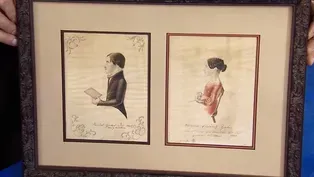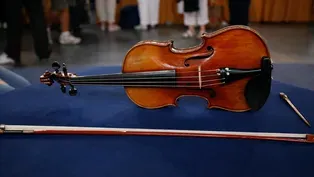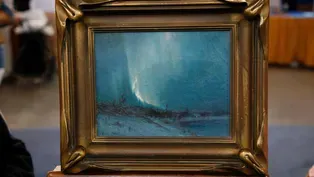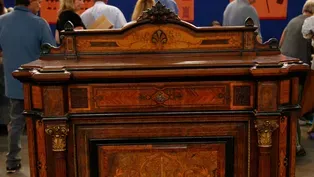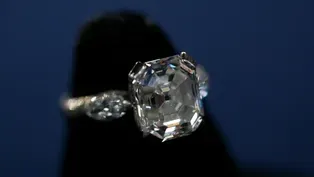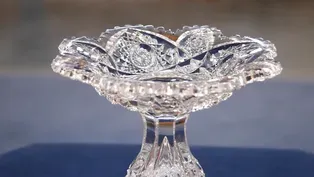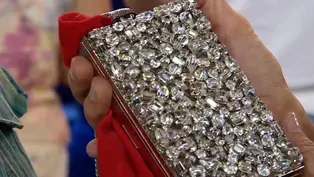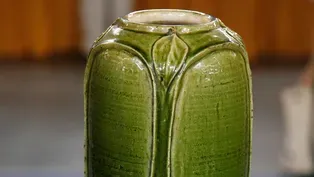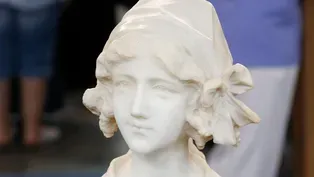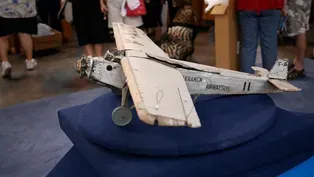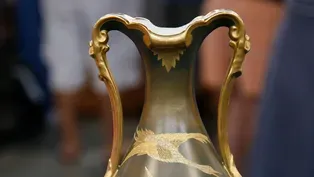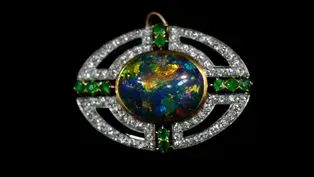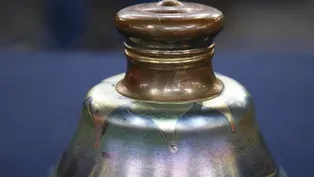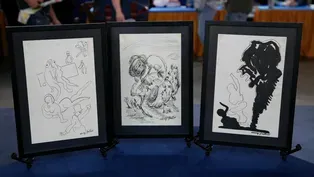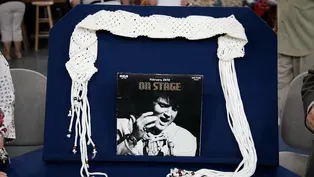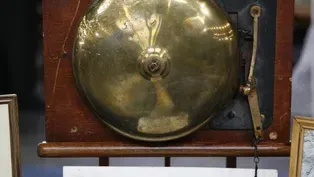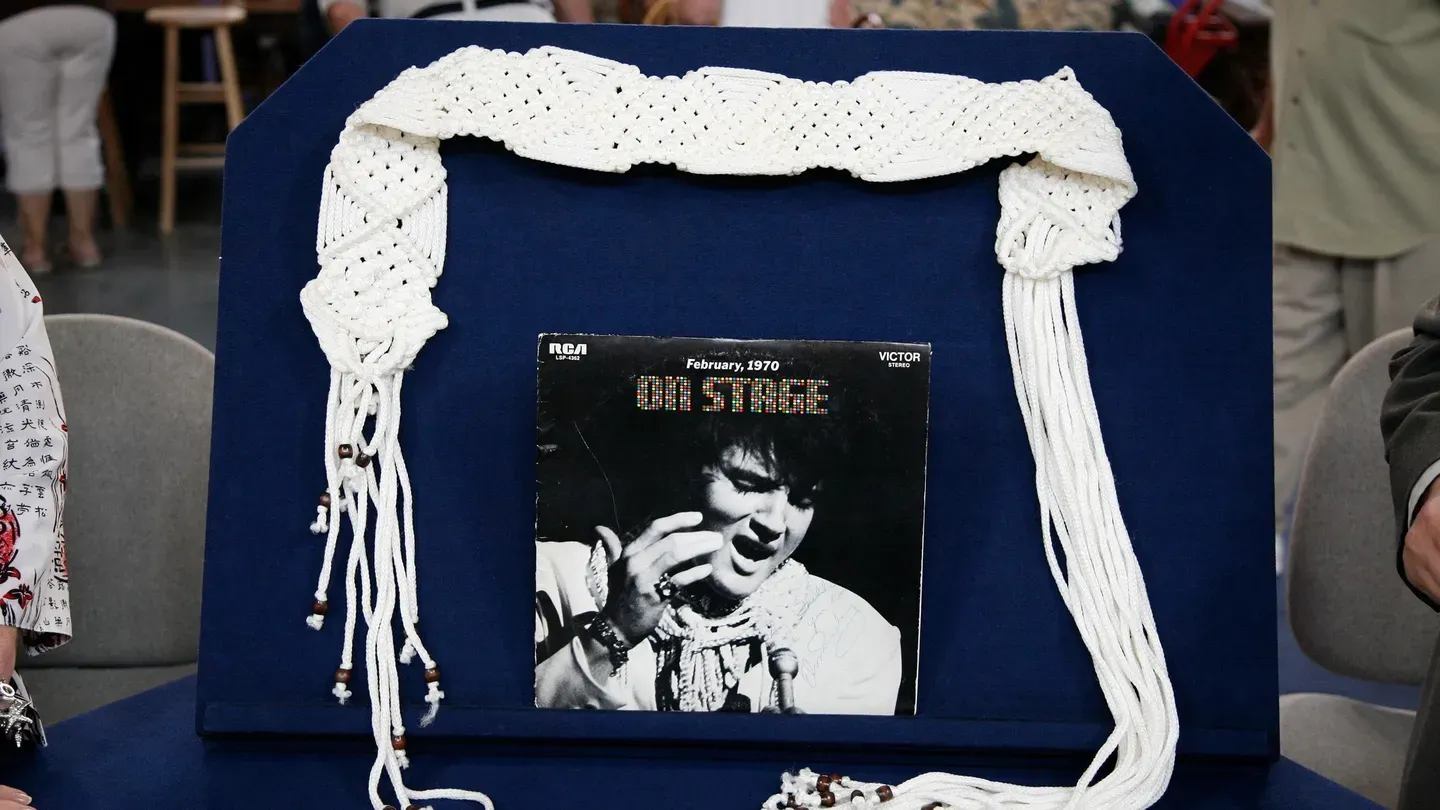

Vintage Las Vegas 2021, Hour 1
Season 25 Episode 12 | 53m 58sVideo has Closed Captions
14 years later, do Las Vegas appraisals still hit the jackpot? One is now worth $165-$175K
Learn if Las Vegas appraisals still hit the jackpot 14 years after ROADSHOW’s visit. Catch an antique asscher-cut diamond ring, a 1923 Dempsey vs. Gibbons fight bell, and a 1970 Elvis Presley-signed album and belt. One is now worth $165,000-$175,000!
Problems with Closed Captions? Closed Captioning Feedback
Problems with Closed Captions? Closed Captioning Feedback
Funding for ANTIQUES ROADSHOW is provided by Ancestry and American Cruise Lines. Additional funding is provided by public television viewers.

Vintage Las Vegas 2021, Hour 1
Season 25 Episode 12 | 53m 58sVideo has Closed Captions
Learn if Las Vegas appraisals still hit the jackpot 14 years after ROADSHOW’s visit. Catch an antique asscher-cut diamond ring, a 1923 Dempsey vs. Gibbons fight bell, and a 1970 Elvis Presley-signed album and belt. One is now worth $165,000-$175,000!
Problems with Closed Captions? Closed Captioning Feedback
How to Watch Antiques Roadshow
Antiques Roadshow is available to stream on pbs.org and the free PBS App, available on iPhone, Apple TV, Android TV, Android smartphones, Amazon Fire TV, Amazon Fire Tablet, Roku, Samsung Smart TV, and Vizio.
Buy Now

ANTIQUES ROADSHOW 2025 Tour!
Enter now for a chance to win free tickets to ANTIQUES ROADSHOW's 2025 Tour! Plus, see which cities we're headed to!Providing Support for PBS.org
Learn Moreabout PBS online sponsorship♪ ♪ I sat on this chair.
My father sat on this chair.
Probably his father, as well.
You made Vegas what it's supposed to be, a place where Elvis is remembered.
I made a very good investment, didn't I?
APPRAISER: You did.
(laughing): You bet I did.
You bet you did.
♪ ♪ CORAL PEÑA: "Antiques Roadshow" last visited Las Vegas in 2007.
Back then, guests lined up to see if they hit the jackpot with their heirlooms and yard sale finds.
Some lost and some won big.
But what happened in the marketplace over the past 14 years?
Have new winners emerged?
Find out in this fresh look at Las Vegas.
This one has hung in my bedroom for the last almost 20 years.
I bought her in 1988 in New York City.
It's an Italian poster, actually, because it's printed by Ricardi, I think.
And the other one I've had since '91.
And I bought her at an auction, and I just love both of them.
And I'd like to know, you know, whether I made a good investment, because I did give quite a bit of money for them at that time.
Well, tell me what you paid for them.
Well, I gave $3,400 for this one in 1988, which was a lot of money, and that one was $3,000 in '91.
Now, the artist of that poster is an Italian gentleman by the name of Leopoldo Metlicovitz, one of the masters of the Italian Art Nouveau, the Secession or the Liberty style.
A great Art Nouveau concept, obviously, a very beautiful woman.
A very seductive image, rather becoming.
I know I am attracted to it.
(laughs) I think I can understand why you are.
Yes.
This image here, a little bit earlier.
This is 1896, by a Belgian artist named Privat-Livemont, who is considered one of the greatest of the Belgian Art Nouveau graphic designers.
He's Belgian?
Oh.
Belgian.
And you want to know whether you made a good investment.
Yeah.
Don't you know the old mantra, "Never buy art as an investment"?
Yeah.
Only buy what you like, that way you can't lose.
Yes.
Well, I bought what I like, because I loved them and I didn't really care how much they were.
And buying, buying what you like is important.
It always makes you feel good and obviously, you have very exquisite taste.
There's another saying that goes, "Spend money to make money."
Now, when you bought them, you paid top dollar for them.
I did, I knew that.
You paid top dollar, but I think you made a good investment, and here's why.
The piece close to you, the Metlicovitz, currently, at auction, you could sell this poster for between $8,000 and $12,000.
Ooh, okay!
So on this poster here, you said you bought for $3,000 in 1991.
And this poster really is the epitome of Belgian Art Nouveau.
It's actually an iconic poster.
It's advertising absinthe, a mysterious drink, the Green Fairy, and here's a woman holding up a glass of absinthe as if praying to it, and the fantastic details in the back: the, the floating smoke, the absinthe swirling in the glass, the woman's very stylized Art Nouveau hair-- these are all classic elements of a great poster.
Currently, at auction, you could sell this poster for between $12,000 and $18,000.
Oh, at auction!
Oh, wow.
And I've examined the condition of this poster, and it's an absolutely perfect condition, which helps me feel encouraged that you'd be able to achieve closer to the higher end of that mark.
Wow.
So, I probably should insure them.
You should insure this one for $18,000... $18,000?
And you should insure that one for $12,000.
They're fabulous pieces.
Yes.
You know, a 300% or 400% return is pretty good.
It's not bad.
I've been investing a lot of money in blackjack this week... (laughs) With very opposite returns.
APPRAISER: I understand you grew up playing the violin.
Is that correct?
Yes, I did.
And that you acquired this instrument when?
In 1984.
Was this your first full-sized violin?
Actually, it was my second one.
I traded in my first one when I was a little girl.
My mom actually bought this one for me with my violin teacher in Venice, Florida, at a music store.
I know it's from the 1920s.
Mm-hmm.
And I've tried looking up the name on the internet.
I've tried looking at books, and I just haven't been able to find any information on this violin.
You must have been a pretty serious player.
In my younger days, yes.
It's been sitting around in a closet for the past few years.
Do you have any idea what your mother paid for it?
Maybe about $500.
Well, it's a lovely instrument.
The label is absolutely perfect, beautiful label.
It says "M. Nebel and Bro.
"fecit, New York, 1921," and then in little tiny writing, it says "Sept. 15," and then there's a family crest in there.
So, it's about as complete a label as we ever can find in this business.
Wow.
M. Nebel was Martin Nebel.
He was from a violin-making family in Mittenwald, Germany.
On the left-hand lower corner of the label, it says "F, period, N, period," handwritten in ink.
You can see on the back that the wood is absolutely gorgeous.
The back of the violin is made out of maple, and the belly, as the tradition, is spruce.
The ribs, the neck, and the scrolled pegbox are also maple that matches the back.
And it's wood that's indigenous American wood, and his carving is of the highest quality.
The thing that I think is really important about this instrument is that it represents the transfer of a tradition from Europe to America, the finest, finest training coming to America to serve the, the young orchestras of the United States and the players.
And yet he did things that were kind of unusual.
The purfling is what surrounds the instrument, and you can see it comes into these corners and swoops right out.
Well, there's no traditional maker that would really do this.
It's very American thing to do.
This instrument, it's had some repairs, and I understand that your teacher did those repairs for you.
They're not done in a particularly beautiful fashion, but I'm sure they've held all these years.
Yes.
I understand that you acquired the bow separate.
Yes, I got the bow a few years after I got the violin.
My mom bought it for me for Christmas.
Mm-hmm.
And the bow, she paid, I think it was about $200, $250.
And that, it's not worth much more than that right now.
Well, this instrument, as is, in a retail market today, would probably be worth $6,000.
Oh, my gosh.
And if those repairs hadn't been made, it would probably be more like $7,000 or $7,500.
Oh, my goodness.
My father's family is originally from Newburyport, Massachusetts, and this document is my great-great-great-grandfather's.
He was a man of color living in Newburyport, Massachusetts, and this documents allowed him to travel to the South, where he had relatives.
It's dated 1815, and my father passed that down to us and we treasure it.
And this we call the grandfather's chair.
Yeah.
Now, we're not sure which grandfather.
We know it was my father's grandfather, but if it was his father, we don't know.
There are various dates under here.
1850-something, 17-something.
We just always sat in it.
You can see the bottom is quite worn.
And you sat on this chair?
I sat on this chair.
My father sat on this chair.
Probably his father, as well.
You can see, it's taken quite a beating.
It's a great heirloom.
This is a passport.
Okay.
It's very straightforward document.
And as we see, it's from Essex, town of Newburyport.
It's notarized by a man called Woart, W-O-A-R-T. Mm-hmm.
And he is justice of the peace.
It's got his seal...
Yes.
...and signature.
And as you said, the date of 1815.
The date.
It's suffered a little bit of bloom and damage.
A couple of holes here.
But essentially, it's a great historical item.
We think so.
Here you have the respect given to a man of color...
Right.
...in the North in 1815.
Right.
It's very early.
And the other interesting thing is, we have crossover here.
Yes.
And, yes, indeed, this is an absolutely genuine Massachusetts-made Windsor chair.
It is?
And as you've said... Oh, my goodness.
It's got some... (laughs) Some repair.
It's had its feet cut down, but it is a child's chair.
Yes.
At auction, the whole package is worth $2,000 to $3,000.
Okay, all right.
But obviously, it is of...
It's, yes.
...tremendous family significance.
Value.
Well, we treasure both items, and this chair has, a lot of bottoms have sat on it, and we love it and hope to just keep passing it down.
Yes.
I bought it here locally, in Las Vegas, about ten years ago at a local antiques store.
The reason I bought it was because of the color.
I paid $65 for it.
What have you found out about it over the years?
Well, I know it says "Belleek" on the bottom.
I know there's a mark there.
I know it says "Fenton."
Okay.
I know Fenton is a glass company rather than a porcelain company.
The mark I think I tried looking up once upon a time in one of the little mark books.
I vaguely remember that it was, like, from the late 1890s, and that's about all I know about it.
Okay, first of all, it has a wonderful, kind of an olive green background color with some gold highlights, and then these hand-painted flying birds.
Okay, right.
Perhaps cranes or something.
They almost have an Oriental feel to them.
Right.
They're very thickly applied, so it's a raised surface, which is really nice.
And then we have this really interesting landscape down below, with water and a little hut of some sort next to the water.
Right, right.
Some rocks on the shore, water plants.
Right.
A really, kind of a charming scene.
We see, you have these wonderful figural, dolphin-shaped handles.
Okay.
They're all decorated with gold.
And then on the back is some interesting stylized plants with this really delicately painted butterfly, again with the raised-gold design.
We'll take a look at the mark here...
Okay.
...and see what we can tell you about that.
Now, on the mark here, it does say "Belleek."
And then there's a crescent, and the crescent actually doesn't say "Fenton."
It doesn't?
It says "Trenton, New Jersey."
Oh!
It's a little hard to read.
Okay.
And yes, there is an American glass company named Fenton... Fenton, okay.
But Fenton didn't make any porcelain at all.
Okay.
If you look closely, there's a letter O and a letter B, which are superimposed over the crescent, and that stands for Ott and Brewer, which was the first company in America which made a Belleek ceramic body.
The Ott and Brewer Company was originally founded in about 1863 as the Etruria Pottery Company.
Eventually they became known as Ott and Brewer, and they made a lot of utilitarian things.
But by the 1870s, they were making some pretty fantastic porcelain in America.
Now, at that point in America, there had not been very many manufacturers of porcelain that had stayed in business very long...
Right.
...or made anything of very high quality.
Now, this vase, we believe, was probably made in the late 1870s or early 1880s.
Oh, oh!
When they were really doing their best work.
Okay.
As far as American Belleek, Belleek is the ceramic body, which was started in Ireland.
The Ott and Brewer Company imported some workers from Ireland who had worked there, and they were the first to make this very thin eggshell-type porcelain that's kind of a off-white color.
Okay.
And we don't see much of it on this piece...
Right, right.
...but we can see it here on the top, this very thin, translucent, eggshell-colored porcelain.
Okay, all right.
Now, one of their early art directors was a man named Lenox, who went on to found the Lenox Company, which is so famous today.
Right, right.
And they were another of the early manufacturers of Belleek in America.
Now, most small pieces will start around $50 to $100.
Right.
And some of the really nice pieces can go up to $500 or $1,000.
Okay, okay.
But this one has exceptional qualities.
This piece is good enough for any museum collection in America.
This piece, we believe, at auction, would sell for between $15,000 and $20,000.
You are kidding me!
Well, thank you so much.
I really appreciate it.
WOMAN: My father got it.
This is from Boston, Massachusetts, many years ago.
I don't know what he paid for this.
It was, I know, under $25.
And you don't know who made this?
I haven't the slightest idea.
There's a nice stamp underneath.
There is, and you're going to tell me what it is.
I'm going to tell you.
It says "Amphora."
Yes.
Okay.
And it is Austrian.
Uh-huh.
It is from the turn of the century.
The value on this here?
Probably $2,000 to $3,000 at auction.
Oh, my God.
Oh, my God!
MAN: The only thing I know about it is that my late father brought it back from the Korean War.
It's a cloisonné work by Ando Jubei, who worked in the Nagoya area near Tokyo at the turn of the previous century.
So we would date this from about 1880 to 1915.
And the craftsmanship is superb.
We think it would bring somewhere between $3,000 and $4,000.
MAN: Wow.
At an auction.
Okay.
WOMAN: This is an evening purse that was my mother's.
I wasn't allowed to touch it, but I could remember she'd go dancing.
My father took her absolutely every place, all over the West.
And I know when they got dressed up, she had that purse on her wrist and she was rocking.
(laughs) This is a great piece.
This is from the 1950s.
This is by Evans.
There's lipstick.
We have a coin change... Now, for ten cents, we're not going to get much today, but at that time, it used to be a phone call.
A phone call.
(laughs) We have a little comb here, and then this opens up to have powder.
Right.
Evans is an American company, and they're known for making compacts, and this is not technically a compact.
It is a purse, beautifully done with just so many different shapes of crystal rhinestones.
We've got squares, pairs, rounds, and even the back.
This is called the Sunburst Design.
And it is worn on the wrist.
That's what this handle is for.
Uh-huh.
And she kept it in such immaculate condition because she didn't let you touch it.
(laughing) And she had it in this little bag, which is a good idea to store rhinestones and other jewelry-- because they can scratch-- in a soft fabric pouch like this.
Yeah, yeah.
Now, the value?
$500.
Wonderful!
(laughing) On July 4 of 1923, there was a world heavyweight title fight in my hometown of Shelby, Montana.
At that time, my father had a tavern in the town, which allowed gambling.
And one of Jack Dempsey's trainers got into my father for quite a bit of money.
After the fight, the trainer came in and presented this bell to my father, who wasn't real happy at the time.
He would've rather had money.
So, he just kind of kept it in the basement for a while, and then later on, we hung it behind the bar.
And it's kind of a thing in Shelby-- when you go into a bar, you buy a round for the house.
And as people would buy a round for the house, we would ring the bell.
A lot of people would come from back East and such to see the bell and to have their picture with it.
And we have a picture of you standing underneath the bell.
How long was this in the bar?
Probably about 60 years.
Shelby really took off as a town in 1922, when oil was discovered there.
Yes, that's correct.
They brought in the railroad and...
Right, and in 1923, it was decided, "Let's take advantage of this.
"We're in the West.
Let's get some personalities over here..." Yes.
"And let's stage this fight."
They actually built a 40,000-seat arena out of wood.
(laughs): Yes, amazing, yes.
Just for the fight.
And then torn down right afterwards.
And basically, they got the fighter of the time, Jack Dempsey, heavyweight champion, and they picked a fighter for him to fight, Tommy Gibbons.
We have Jack Dempsey on the left in this photograph, shaking hands with Tommy Gibbons.
Tommy Gibbons wasn't very well known at the time.
No, that's true.
But he put up a pretty decent fight, went 15 rounds.
Yes, he did.
And Dempsey retained his championship title and it went into history.
And here we have this wonderful bell.
Yes.
You very seldom see pieces like this.
And what's great is, you have great documentation.
In an auction, I would estimate it at $5,000 to $7,000.
Gosh.
So, I know you've heard this bell probably thousands of times.
Do you mind if we ring it one more time?
No, I certainly don't.
(laughing): Okay.
(bell clangs) Very cool.
Now, my aunt had purchased it in 1929 when she was on a cruise to Alaska with her brother, my Uncle Harold.
And she loved this painting.
Loved it, and so did I. I was an executrix on my great-aunt's estate in California, and in her will, she wanted things to go to the schools and to relatives and so forth.
I then put everything I could into certain galleries to sell, and I went over at the auction and I bought it back.
And I paid $3,200 for it.
Right.
And the ladies asked me today whether I thought that was a lot of money.
And I said, "I really didn't care."
I wanted that painting, because it meant a lot to my aunt.
And she liked Sydney Laurence, even though he was a scoundrel, as we all know.
How long ago was this?
1991.
I wanted to look at the back just for a moment.
When you brought it in, you showed me the label on the reverse, and it is dated 1929.
Mm-hmm.
And titled "The Northern Lights."
This is a label that is Sydney Laurence's label.
You know something about Sydney Laurence's life.
Oh... Well, that's why I was surprised that my aunt really liked him so much.
He was a gentleman that left his family, his wife and children, in England.
With nothing!
Right.
And moved to Alaska and became... (clears throat): ...quite a... gentleman.
(laughing) Whatever you want to call him.
Right.
(laughter) If you'd forgive me, I'm trying not to say anything nasty.
But he wasn't that good of a husband or a father.
Yeah, no.
Well, he was born in Brooklyn in 1865, went to a military academy, trained at the National Academy of Design and married in 1889, I believe it was.
And they went right off to England, to St. Ives in Cornwall, where he studied with the St. Ives group there.
Yeah.
I believe his son was born there.
Yep.
And then off he went.
Leaving them behind.
1903.
Yes, yes.
And he is known as one of Alaska's great painters.
There's not many people who painted up there at this time, and he really loved the North.
In a gallery today, I would probably price it about $20,000 to $30,000.
So, it's certain...
There's been a tremendous growth in the interest in these Alaskan paintings, particularly... Did you say $20,000 to $30,000?
I said $20,000 to $30,000.
Then I made a very good investment, didn't I?
You did.
(laughing): You bet I did.
You bet you did.
A friend of mine needed a place to stay.
He came for a couple of days and stayed two months.
And when he left, he said, "I'll give this to you as a payback," and that was 20 years ago.
Well, first thing to do with this piece for me was to establish who made it, because it's different.
I had an idea what it was when I saw it, because a couple of times in the distant past, I saw a piece that's similar to this, and it had elements of the Grueby Pottery of Boston, Massachusetts.
But Grueby is known for their rich, organic, matte glazes.
This is a high-glaze piece, and the tooling on this is much more obvious-- Grueby tends to be a far more subtle pottery.
But upon closer inspection, there are things that suggested to me that it was, in fact, Grueby.
First of all, earlier on, when they were Grueby and Atwood, they weren't doing matte glazes much.
They were doing a lot of high glaze, and this is the green high glaze that they used.
So it wasn't what they were famous for, but it's where they started.
Number two, these ribs that we see going through the body, these throwing ridges?
It's a hand-thrown pot, which is typical of Grueby, and earlier on, they left these throwing ridges somewhat prominently on the surface of the piece.
Number three, if we look inside, that white clay and that kind of crackled effect it has?
That's typical of Grueby from the earlier period and also later on, till about the turn of the century.
The thing that really clinched it for me was the bottom, which is not marked, but this rough, crude look is typical of early Grueby.
What you often see on Grueby pieces is like a shellac surface that's applied after the fire, and you have this orangey, shellacky bottom on the piece, which, as far as I'm concerned, is as good as a mark on any piece of Grueby.
The second thing to establish is its importance, because it's not what people look for when they look for Grueby.
Grueby was the ultimate Arts and Crafts potter in America.
They were influenced by what was happening in France and in England, but they modified it into the New England School of Arts and Crafts.
And this is the missing link, because this is the link between the early crude, derivative, Neoclassical style of Grueby's first work with Atwood to what became high-style Arts and Crafts.
So you see that the things that Grueby's known for, such as these tooled leaves around the outside?
These are kind of coarse and thick and crude, and I think it's absolutely fascinating to see the evolution of Grueby's style.
I have never seen a piece of Grueby from this period in green high glaze, showing these elements just when they were leaving that Neoclassical work into Arts and Crafts work.
So this, to me, is a historically significant piece.
It's not the prettiest piece of Grueby, but I think someone who is an advanced Grueby collector or a museum would be as captivated by it as I am.
Wow.
This has had water in it at one point.
What's happening on the bottom here, this is from water inside leaching through the outside and whatever elements, like whether it was dirt or things from flowers and leaves inside, that will clean off.
By and large, I'd say this is in excellent condition.
If I had to come up with a price on this for an auction estimate, I would probably say somewhere between $10,000 and $15,000.
But, if I put this at auction and somebody paid $20,000 or $30,000 for it, I wouldn't be surprised, because someone who was a major Grueby collector or Arts and Crafts collector, who would have to have this to complete that cycle of evolution of American design, would pay whatever they had to to acquire this piece.
Oh, my God.
I'm stunned.
(chuckles) Well... Not as stunned as I was when it walked in, that I got to tell you.
Help me out of my chair.
(chuckles) That's amazing.
Well, I brought in what I've always called the Little Mermaid.
And you do you think it's a mermaid?
(laughs): No, I don't think so.
There's a long history of mermaids, and these mermaids started appearing in all the wonderful cabinets of curiosities in Europe.
But I think the beginning of the 19th century, when they understood anatomy a little bit more, they realized that they were just very fertile imaginations running riot.
Your mermaid is actually quite desirable in the market.
People love these curiosities.
That's good.
And I think it's probably worth round about $1,000.
Oh, that's great.
I mean, if you would find one from, say, the 16th-century cabinets...
Yes.
...curiosities, you'd probably be looking probably $30,000 to $40,000.
They were that desirable then.
That's very desirable, yes.
Before they knew what they really were.
(laughs): Yes, of course.
That's wonderful.
Well, thanks very much.
Well, this is a family piece.
It's always been handed down.
From what I've been told, it's about 1750, and it was built in Greenock, Scotland.
I can't make out who made it, because the signature is very faint, but it definitely was made in Greenock, and it has typical Scottish features.
I like the clock a lot because it has this beautiful mahogany case.
It's a very narrow-waisted case, really well-proportioned.
This is a clock that would sell anywhere from $5,000 to $7,000.
WOMAN: They are my great-great-grandparents.
They come from Pennsylvania, in the New Berlin area.
I don't know who the artist was, but they're something I love very much.
Well, that was a very German part of Pennsylvania back in 1843.
And it was at a time in history when this was the photography of the day, and they're done in wonderful silhouette pose.
They're watercolors.
The wife is painted by Dittmar.
We don't know exactly who he is-- probably an itinerant artist that operated in that area.
And it's in German, it says "painted by."
The husband's is English.
It says "Done by Dittmar."
So it's a transitional period when there is still German, and English is starting to be phased in.
I think on the marketplace, they're wonderful and probably'd be valued at somewhere in the $4,000 to $6,000 area.
Oh, my goodness.
(laughs) WOMAN: My husband, this was his mother's brooch.
She never spoke about it.
And when she was getting sick, she mentioned to my husband that he should give it to me when something happens.
APPRAISER: Mm-hmm.
And so, that's all I know about it.
Had you ever had the brooch appraised or had anybody talked to you about the brooch at all?
I brought it with me one time when I was having a ring repaired, and the gentleman there said that he thought it was a black opal, but he wasn't sure, and he couldn't give me no sense of value or anything on it.
Well, he was correct.
What we have here is a black opal, diamond, and demantoid garnet brooch.
Now, based on the stones that are in the item and the design, I would date this around 1910.
Now, the center stone here is the black opal.
The reason these are called black opals is because they have a very dark contrasting background.
Uh-huh.
And if we looked at the back of the piece, we would see that the background material is a very dark gray color.
Uh-huh.
Whereas in the front, you get this large array of multicolors.
It's the way the natural matrix occurs.
Is it?
And these green stones here are the demantoid garnets.
It's a very rare form of garnet that...
Most garnets are red, but these are green.
Wow.
And what they were obviously doing was using the green material to pick up the green in the opal.
I see.
Black opals are known for their what we call "fiery" quality, meaning that there's lots of color that is in the stone.
This stone is exceptional because it has all the combinations of color.
It has yellow, it has orange, it has green, it has blue.
But most importantly, it has red.
And red is the one color that really makes this whole stone not only pop color-wise, but in terms of what a connoisseur of opals would look at and judge... Uh-huh.
...is that this is really an exceptional stone.
The brooch is also set with round old-European-cut diamonds, and there's an approximate total weight of three carats worth of diamonds in the brooch.
The other nice thing is that it's a very simple design, it's very streamlined, and also is very typical of this time period.
On the back of the brooch, it says "Shreve."
Now, Shreve is a very well-known jeweler in the San Francisco Bay area.
Oh.
And so what we have here, the combination of a number of factors, a Shreve & Co. black opal and demantoid brooch from the 1900s.
I would say, at auction, this would bring anywhere between $15,000 and $20,000.
Wow, wow.
(laughs) Ooh!
It's quite a bit.
(chuckling) WOMAN: I skated with an ice show and we played Nashville, Tennessee, right after Elvis came out of the service.
And we invited him to the show.
In return, he invited us to his house for a party.
So when he came to Las Vegas at the International Hotel, two of my girlfriends and I went to see his show, and we met one of his bodyguards, Sonny West.
And he took us down to say hello to Elvis, 'cause we had met him at the party.
I came back about three nights later to see the show again, and ran into Sonny, and he took me back down to the dressing room again.
And I was kidding around with Elvis and asking him about his macramé belts, if he made them himself.
And of course, he said no.
He was teasing me, he said he had stayed up all night long making them.
Well, when he went in to get dressed to go up to the stage, he came back out and he had the macramé belt in his hand and just kind of pitched it to me.
That's great.
And gave it to me.
So, I've had it ever since then.
This was in the '70s.
Okay, and the record album?
And the record album he gave me about three nights later, when I went down.
He gave me a record album, had signed it for me.
It's a great story.
Oh, thank you.
It's pretty good to be able to meet a celebrity like that.
Oh, he...
He was wonderful.
He was such a wonderful man to talk to, and very handsome-- very handsome man.
Well, the record album's interesting, because Elvis did sign quite a bit of things.
Some that I see very often, scraps of paper, letters, things of that nature.
Not very often on, on record albums.
Not unheard of and not super-rare by any means, but it's really nice.
I'm going to give you estimates based on what I think they would sell for at auction.
On the album, you can see it's actually inscribed to you.
It's to Freddie, and it's signed by Elvis Presley.
I think a fair auction estimate for that would be $1,200 to $1,800.
Okay.
Okay, that's for the record album.
Yeah.
Now let's take a little step up a bit and we'll talk about the belt.
You're talking about something that's personal memorabilia that was actually worn by a world-famous celebrity.
A piece like this at auction, I'd put a fairly conservative estimate at $6,000 to $8,000.
Oh, okay.
So, as a package, both pieces together-- again, a fairly conservative auction estimate-- maybe $7,500 to $9,500 on the pair.
It's just great stuff, and if you're going to put an insurance value on it, you'd probably want to insure it for a little bit higher.
Maybe $10,000 for the two pieces.
Okay.
I'm glad you brought it down, and you made Vegas what it's supposed to be, a place where Elvis is remembered.
MAN: It's something that I've had in my possession now about 35 to 40 years.
I wanted to have some Tiffany if I possibly could, or something similar, for my desk in the office.
I've always followed Tiffany, and thought he's a remarkable individual, a great artist, as we all know, especially in colors.
And about that time, something was in one of the antique articles, and they were mentioning an inkwell that they thought was somewhere around 1915 to 1920.
It was a reasonable price at that time, and so I ended up having it sent to me.
I put it into a glass closet and kept it there and looked at it for many, many years.
And I really haven't gotten it out of that glass chest, except just recently.
When we think about inkwells with Tiffany, we think about their bronze inkwells, or we think about the bronze and glass inkwells that were part of a desk set.
This piece was never part of a complete desk set.
The colors on this are fantastic.
I love this little hook decoration, this kind of wave decoration that goes all the way around, and then it comes down from the top right over that shoulder.
You have this wonderful bronze lid that has a hinge on the back, and what I've noticed about it is, it has a little bit of condition issues.
It looks like at some point in time, somebody took tape, probably to tape the lid down shut.
Maybe if it was being shipped or if it was being stored.
So you have these little four spots where you can see tape was.
It took away from the patina that was on it.
And for a few hundred dollars, you can actually get them re-patina'd.
Oh, really?
And have them fixed so that they look brand-new.
On the bottom, you've got this pontil mark here, and then you've got an "L.C.T."
and then an "H" and a three-digit number behind it, which shows this was an early piece.
This would be something that would have been done around the turn of the century.
Oh, really?
Yeah, so a little bit earlier than what you thought for it to be.
If you don't mind, how much did you pay for the piece?
I think it was $600.
The Tiffany market is very, very wild right now, and we don't see these kinds of inkwells come up very often.
I would say if this came up at auction, you would expect to see an estimate of $6,000 to $8,000.
(chuckling): Really?
There's a pretty strong possibility that it would sell for even more money than that.
MAN: My father was a newsman for the Voice of America, and in the late '50s or early '60s, he interviewed Woody Guthrie for one of their cultural programs.
And the story is that my father noticed these drawings on the table next to Woody and admired them, and Woody Guthrie pulled these three drawings off the top of the pile and handed them to him.
It's a wonderful story, and impeccable provenance, too, if I may say.
Do you know much about the rest of his drawings or his other artworks?
Only a little bit.
I recently got a book about it by Nora Guthrie, and all I know is there aren't very many of them in circulation.
Most of them were in his diaries, in his journals, and so on, but that's about all I know.
As far as I'm aware, many of them are actually in the Woody Guthrie Archive in New York.
He'd started drawing quite early on.
Around about 1939, he was doing illustrations for the "Woody Sez" column that he used to write.
And he was also known for doing drawings for his book "Bound for Glory," of course.
And he worked in series.
He did a series of drawings of Sacco and Vanzetti.
Wow.
He did works around Coney Island.
And he even did portraits and cartoons and all, all sorts of things like that.
I was very impressed by the economy of line and the great directness of the imagery in these works.
I suppose we shouldn't be too surprised by that.
He didn't mince words and immensely creative when it came to self-expression.
So I can imagine, when he didn't feel the lyrics were working, maybe he decided to do some drawings and see how that would work.
It's interesting, because they fall into an area which is part collectibles, part fine art, part, you could almost argue, rock and roll-folk memorabilia.
So you have a number of different groups I think would be interested in, in these works.
Now, when exactly was that they were acquired from?
Late '50s, '60s.
Yes, because of course by then, he, he was suffering very badly from Huntington's chorea, which is a degenerative disease.
Yes.
I've spoken to one of my colleagues who deals specifically with collectibles and autographs.
And he had told me that just an autograph, such as this by Woody Guthrie, would be worth at least $1,000 to $1,500.
And so on that basis, one must assume that for an original artwork, these should be worth at least, I would have thought, $3,000 to $5,000 each at auction.
Thanks very much for bringing these in.
Thank you.
Well, I got them a few years ago from my aunt, and it was passed down from my great-grandfather.
If we just look at the front, these are very typical Berlin-painted plaques, made about 1895 to 1905, in that time frame.
They both have a similar mark, and I'll turn this one over, and the marks are always very, very faint.
And they are an impressed mark.
MAN: Okay.
And it's impressed "K.P.M."
KPM is the Royal Porcelain Manufacture of Germany, and that's the one you want to find.
Each of them in a good retail establishment should be in the $7,500 to $8,500 range.
Okay-- each.
Each, absolutely.
Okay, okay.
Take them home, frame them nicely and securely, and enjoy them.
All right.
Thank you very much.
Thanks for coming in.
All right, thank you.
I really like your necklace.
I see a lot of these Navajo squash blossom necklaces here at the Roadshows.
They were made by the thousands, especially after Sonny and Cher made them popular on their TV programs and the Ralph Lauren movement.
But this one's really quite handsome, and it has some age.
This particular one's from the 1930s.
Where did you get it?
Um, I acquired it cleaning up some trash.
It fell out of a trash bag.
It's a wonderful, heavy coin silver 1930s Navajo squash blossom, which today, if you were to set this free in an auction market, you'd get about $1,000 to $ 1,500 for it.
Wow!
So that's a nice daily perk.
That is a very nice, yes, nice one.
Well, congratulations, I love it.
Thank you.
WOMAN: It was a gift to me from my father.
APPRAISER: Do you know what it is?
It's a drinking gourd, I'm pretty sure.
And I know that little clip there's, I think, to hang it on your belt.
That's about all I know-- I just really love the sun, so...
I've been doing the Roadshow for 12 years and I've never seen a drinking horn.
Oh, wow.
It's called a drinking horn.
Okay.
Now, I think he could have hooked it to his belt, but if he would have had, you know, a rifle, and had his powder horn down here, then he could have hooked it on there.
I love this saying, "Drink ye thirst away."
Away, yeah.
And when you get to the date, 1766, that's a pretty good mind blower, too.
Yeah.
And I think our favorite thing is the same thing here, right?
Yeah.
The sun face.
Yeah, definitely.
I love the way they did the mouth to make it look like he had an open mouth.
Yeah.
With little nostrils in there.
Yeah.
We're all in agreement that this is a great thing, probably worth $3,000 to $5,000.
(chuckling) Cool, that's great, that's great!
MAN: I found this in a swap meet in Southern California.
It was a part of an estate that was being sold at the swap meet, and it was sitting on the ground and it had a handwritten note on it that said "movie prop."
So I got down on my knees and looked at it, and I determined by looking at it that I agreed that it was a movie prop.
So I asked the gentleman who was selling what movie it was from, and he, he told me a title that I believe was "The Wings of an Angel."
That movie, or that title, did not match up to any movie that I was familiar with.
I've never heard of it.
So, I sort of hemmed and hawed about whether or not I wanted to purchase it, because I could not remember any movie with that title.
And I had decided, ultimately, to, to not purchase it, and I walked away.
Now, how much was it?
He was asking $250.
So as I was walking away, he just said, "Oh, the only other thing I know about it is, is that Cary Grant starred in the movie."
And as soon as he said that, I knew exactly what movie it was.
I knew it was "Only Angels Have Wings," and I knew that it was a Howard Hawks film.
I knew that Jean Arthur and Cary Grant and Rita Hayworth were in it, but what I couldn't remember was, in the storyline, the name of the airline.
I ultimately bargained with him and got the price down to $195, and I loaded it in my car, and I drove about as fast as I could around the corner to a local bookseller, and I ran up the stairs and I found the first biography I could of Cary Grant, and I flipped it open to "Only Angels Have Wings," and there it was, Barranca Airlines.
That's fantastic.
And you've really done your homework.
You brought in the DVD and we looked at it.
And there you can see it, when you freeze the frame.
It's a beautiful shot, you come right in, and there's no question this is the model.
Absolutely.
And of course, that's very important in this market, when you have visual evidence that it was the actual prop that was used in the movie.
In the '70s, a lot of the movie studios sold off their props for giveaway prices-- it was a shame.
But recently, I'd say within the last six or eight years, a lot of specialty auction houses have made such a market out of movie props.
I mean, they're selling movie props from movies that were made last year, and getting amazing prices.
But when you come up with a movie prop from a movie made in the 1930s, and when you come up with a movie prop that was from an important Hawks movie, it's just fantastic, and to be able to nail it down with that scene in that movie, it's, it's really extraordinary.
Value is a hard thing to say, because let's face it, this is it.
Right.
There's not a half a dozen of these out there that've been floating around...
Right.
...that we can really test the market with.
But I've consulted with some friends of mine.
I think this could sell easily in today's market for $5,000.
Wow.
So I think a $200 investment was a very good play.
Who knows?
This has not only appeal to movie buffs, but also to people who collect aeronautical memorabilia.
That's great-- I can't believe I balked at paying $250 for it.
(laughs) I inherit this picture from my aunt, and I just grabbed it off the wall.
Did she collect a lot of paintings?
Yeah, she has a lot more, but I just got that one.
Do you know who painted it?
No, I didn't.
That's why I brought it.
Okay.
I want to know something about it.
Okay, well, it's signed down here.
And I had a hard time reading it myself.
The letters are all together, and they're dark on dark, so it doesn't read as well.
But it says "Ada Belle," and then the last name is Champlin, C-H-A-M-P-L-I-N. Oh!
Okay.
Champlin was an artist who was born in St. Louis, and then who studied in Chicago and other places.
Oh, okay.
And came out to California around 1910, so she's known more for the California scenes.
Oh, okay.
And this is very typical California scene.
As you see the bright sky and the brownish hills, and the live oak tree here.
Oh, okay.
Is very typical of California landscapes.
Oh, okay.
And this sort of brownish grass.
Now, this painting is not on canvas.
Do you know what it's, what it's painted on?
No, I never knew.
I didn't know what it was painted on.
Well, we can actually hit it-- it's not going to hurt it.
It's actually on a hard board.
It is?
It's on a board called Masonite.
Masonite is a fiberboard.
Oh.
And it has a very smooth side.
Okay.
And then a rough side, which is more fibrous.
And you can see it here, if you can see that pattern right there?
Oh, yeah, oh, yeah, I can see that.
It makes it easier for the artist to have the paint pulled off the brush because it's rough.
But the thing about it is, it tells us when this painting was painted.
Now, she lived 1875 to 1950.
But since Masonite really wasn't used until 1930, we know this painting was done somewhere between 1930 and 1950.
Oh, wow.
Now, your aunt, she could tell you how much she paid.
She never talked about money.
Didn't, okay-- okay.
She never did.
Well, it's in its probably close to original frame.
It's a little dirty, you might want to get it cleaned.
Okay.
It's got a little yellow.
The market for Ada Champlin a few years ago wasn't very strong, but the market for California paintings, it's one of the great regional schools in America.
Okay, wow.
Now, there's a big market for California paintings.
Wow.
If I were to put this in auction, I would probably expect you to make $5,000 to $7,000 for this at auction.
Wow!
I would never have thought.
That picture?
Oh, my goodness.
(laughing) It's been hanging there for two years, and I just look at it and walk on.
I'll be paying a lot more attention to it, that's, that's for sure.
Wow.
So, it's 70, 80 years old.
Yeah, I know.
That's hard to believe.
(laughs) Wow, thank you very much.
Well, it's a joy to see it.
Thank you.
Dang, that was something else.
I don't believe that one.
WOMAN: My family lived in Florida, and we were going to visit my grandfather in Wisconsin.
So on the way, we stopped at an antique shop in Chicago, and my dad found this piece.
It was on a dresser that they had varnished.
So the piece was actually stuck to the varnished table.
And my dad spent about three hours working it off of the table... (laughs) ...so it wouldn't, it wouldn't affect the bottom of the, the piece.
And we've had it ever since I was about seven or eight, and we called it a baptismal for lack of anything else to call it.
Now, do you remember what he paid for it?
$25.
And what year?
I would say in the early, early '60s.
First of all, it is American Brilliant Period cut glass.
That's the best glass ever made in cut glass in America.
Around 1880 until World War I was the heyday for cut glass.
This is earlier, in, like, the 1880s, 1885.
These are teeth all around the edges here.
And we checked these teeth, and they're perfect, perfect condition.
You look for cut glass to be in perfect condition.
On the inside, we have a Hawkes mark, for T.G.
Hawkes Glass company.
And they used Corning blanks and cut their glass from Corning blanks.
It's about an 1880s mark.
And it's a trefoil mark mark with the birds.
The piece is quite heavy.
It has this zipper pattern here.
And so, are you calling it a compote, or you call it a baptismal?
We, we actually call it a baptismal.
And was it used for a baptismal for you?
For me, yes, yeah.
For you.
And it's wonderful that it was used for that.
Uh-huh.
However...
If we turn this upside down... we are now... right side up.
Okay.
What we have is the base to a fabulous bowl.
A bowl would have gone in here, and it would have been huge.
The way you could tell was that the mark on the bottom should have been on the bottom, not on the top.
The top.
And then you see this teardrop in here?
Can you see that?
Uh-huh.
Through the center?
Well, it's pointing in the right direction.
The retail value of the base and the insurance value would be roughly the same, and it would be worth about $500 as it is.
Now, if you can get on a search and find the bowl that went with it, it would be $4,000 to $5,000.
Not easy to find.
Right.
But now you know...
I do know.
(laughing): ...the rest of the of the story.
(laughing): The rest of the of this story.
Well, it's good to know.
Thank you, Kathy.
Thank you.
WOMAN: My grandfather owned a jewelry store in a real small mining town, and it was a jewelry store/ pawn shop/ sporting goods store.
APPRAISER: Were they mining diamonds by any chance?
No, the town mined millennium, it was in Leadville, Colorado.
He passed away ten years ago, and this is one of the pieces that was in all of the things that he left for me.
And he made this ring for you, you said?
That was the story.
Okay.
I mean, I don't, I don't know.
You have an Asscher-cut diamond ring.
It's approximately five carats 20.
It's a "G" color, VVS 2, very, very clean stone.
And there is a mark in here.
It wasn't made by your grandfather Oh.
It was made by a company called Birks.
And they were a Canadian firm that worked around 1915, 1920.
A very reputable firm, made some very nice jewelry.
It's all set in platinum with pierced platinum work, sometimes called an open-work setting, and it has diamond shoulders on here, and it's typical of a ring produced around 1915, 1920.
A phenomenal piece of jewelry.
And we really find very, very, very few Asscher-cut stones.
Certainly that color, that quality, and that size.
Did you have any idea of the value of the ring?
Not really, I mean...
I've seen other rings in jewelry stores, but no, not really.
Well, I'd say that if you were to walk into a retail store today and try and purchase a ring like this, it would easily cost you $165,000 to $175,000.
Really?
(chuckles) Okay.
PEÑA: You're watching "Antiques Roadshow: Vintage Las Ve PEÑA: And now it's time for the "Roadshow" Feedback Booth.
Yesterday, this was a "vayse," and today it's a "vahse."
It was given to my grandmother and it's worth about $1,000.
And I have here my picture of David Bowie by Linda McCartney.
It took me three months to pay off in 1988, and I found out it's worth $1,500.
This is a slide I was showing, people in the fields, and we found out that they're worth about $300, and we were going to make our down payment for our house with what we brought.
But we found out, because of the price, we're able to afford a house about this big.
We have Asian antiques!
Look at these!
Not really worth anything.
The guy said, "Buy a meal instead next time you're in China."
But we had fun.
Found out that my hat that was handmade for Paramount Studios in 1940 for one of the movies is worth about $300 to $500.
That's a lot more than I paid for it.
It's been a good day.
Right.
(laughs) We brought this pillow.
I was hoping it would be worth about five dollars so I could throw it away when I got home.
It's now $200, and it's going to be framed in our front room.
I did some research, thinking it was Ellice, E-L-L-I-C-E.
So I did research thinking it was Ellice T. Johnson.
But I came here today and they say it's 371113.
It's worth between $500 and $1,000.
Not bad!
PEÑA: Thanks for watching.
See you next time on "Antiques Roadshow."
WOMAN: It was in a lady's house, and her granddaughter was holding an antique sale.
APPRAISER: And what did you pay for her?
$300 to $400.
Something in that range.
Uh-huh.
She's Italian, from the late 19th century.
When we first looked at this, it appeared to be marble.
But on closer examination, we decided that it is actually alabaster.
At auction, it would probably go somewhere between $2,500 and $3,000.
That's very good.
The fact that she has such a beautiful face, that also adds to the value.
MAN: It's an inherited piece through my wife's family.
We really don't know too much about the piece.
APPRAISER: Okay-- it's difficult to determine origin for pieces of furniture made in the 19th century.
America experienced a tremendous amount of growth from 1850 to 1900, and there was furniture factories virtually from California to New York.
So, some of the things we look for can indicate the region in which a piece was made.
And in this particular piece, we can see that it has a lot of decorative elements and a level of quality that's consistent with furniture produced along the Atlantic seaboard.
But I think that we feel safe to say that it was a very skilled cabinetmaker working in the Mid-Atlantic region, probably New York.
And you think of mid-19th century?
Is that... About 1870, 1875.
Today's market, value on it at auction would be about $2,000 to $3,000.
That's actually more than I was anticipating.
Oh, that's good.
In fact, I was actually expecting you to say that it was a European piece, judging by its ornateness, and, uh... Good.
So I'm kind of pleasantly surprised that it's American-made.
Appraisal: 1843 W. Dittmar Watercolor Portraits
Video has Closed Captions
Clip: S25 Ep12 | 1m 10s | Appraisal: 1843 W. Dittmar Watercolor Portraits (1m 10s)
Appraisal: 1924 Martin Nebel & Brother Violin
Video has Closed Captions
Clip: S25 Ep12 | 3m 6s | Appraisal: 1924 Martin Nebel & Brother Violin (3m 6s)
Appraisal: 1929 Sydney Laurence "The Northern Lights"
Video has Closed Captions
Clip: S25 Ep12 | 2m 34s | Appraisal: 1929 Sydney Laurence Painting "The Northern Lights" (2m 34s)
Appraisal: Ada Belle Champlin Landscape, ca. 1940
Video has Closed Captions
Clip: S25 Ep12 | 2m 28s | Appraisal: Ada Belle Champlin Landscape, ca. 1940 (2m 28s)
Appraisal: American Cabinet, ca. 1870
Video has Closed Captions
Clip: S25 Ep12 | 1m 5s | Appraisal: American Cabinet, ca. 1870 (1m 5s)
Appraisal: Art Nouveau Posters, ca. 1896
Video has Closed Captions
Clip: S25 Ep12 | 3m 17s | Appraisal: Art Nouveau Posters, ca. 1896 (3m 17s)
Appraisal: Asscher-cut Diamond Ring, ca. 1915
Video has Closed Captions
Clip: S25 Ep12 | 1m 52s | Appraisal: Asscher-cut Diamond Ring, ca. 1915 (1m 52s)
Appraisal: Cut Glass Centerpiece Base, ca. 1885
Video has Closed Captions
Clip: S25 Ep12 | 3m 11s | Appraisal: Cut Glass Centerpiece Base, ca. 1885 (3m 11s)
Appraisal: Evans Rhinestone Sunburst Carryall, ca. 1950
Video has Closed Captions
Clip: S25 Ep12 | 1m 28s | Appraisal: Evans Rhinestone Sunburst Carryall, ca. 1950 (1m 28s)
Appraisal: Grueby Pottery Vase, ca. 1897
Video has Closed Captions
Clip: S25 Ep12 | 3m 37s | Appraisal: Grueby Pottery Vase, ca. 1897 (3m 37s)
Appraisal: Italian Alabaster & Micromosaic Bust, ca. 1895
Video has Closed Captions
Clip: S25 Ep12 | 35s | Appraisal: Italian Alabaster & Micromosaic Bust, ca. 1895 (35s)
Appraisal: "Only Angels Have Wings" Model Plane, ca. 1939
Video has Closed Captions
Clip: S25 Ep12 | 3m 17s | Appraisal: "Only Angels Have Wings" Model Plane, ca. 1939 (3m 17s)
Appraisal: Ott & Brewer American Belleek Vase, ca. 1880
Video has Closed Captions
Clip: S25 Ep12 | 3m 41s | Appraisal: Ott & Brewer American Belleek Vase, ca. 1880 (3m 41s)
Appraisal: Shreve & Co. Black Opal Brooch, ca. 1910
Video has Closed Captions
Clip: S25 Ep12 | 3m 4s | Appraisal: Shreve & Co. Black Opal Brooch, ca. 1910 (3m 4s)
Appraisal: Tiffany Studios Blown Glass Inkwell, ca. 1900
Video has Closed Captions
Clip: S25 Ep12 | 2m 29s | Appraisal: Tiffany Studios Blown Glass Inkwell, ca. 1900 (2m 29s)
Appraisal: Woody Guthrie Drawings, ca. 1960
Video has Closed Captions
Clip: S25 Ep12 | 2m 33s | Appraisal: Woody Guthrie Drawings, ca. 1960 (2m 33s)
Appraisal: Elvis Presley-signed Album & Belt, ca. 1970
Video has Closed Captions
Clip: S25 Ep12 | 2m 50s | Appraisal: Elvis Presley-signed Album & Belt, ca. 1970 (2m 50s)
Appraisal: 1766 Carved Drinking Horn
Video has Closed Captions
Clip: S25 Ep12 | 1m 21s | 1766 Carved Drinking Horn from ROADSHOW's Special: Tasty Treasures (1m 21s)
Appraisal: 1923 Dempsey-Gibbons Fight Bell
Video has Closed Captions
Clip: S25 Ep12 | 2m 13s | Appraisal: 1923 Dempsey-Gibbons Fight Bell, in Naughty or Nice (2m 13s)
Providing Support for PBS.org
Learn Moreabout PBS online sponsorshipSupport for PBS provided by:
Funding for ANTIQUES ROADSHOW is provided by Ancestry and American Cruise Lines. Additional funding is provided by public television viewers.


